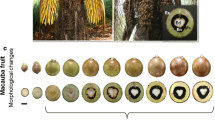Abstract
Attalea colenda is a monoecious palm found in pastures in coastal Ecuador. In dry regions, it is a valuable source of oil in self-sufficiency farming or in combination with cattle in pastures. The palm was studied over a gradient of dry to humid environments during two fruiting seasons. Palm growth, production of leaves, inflorescences, and infructescences, number of fruits per infructescence, and seed weight of five populations were evaluated. The individual of average size is 15 m tall, which corresponds to approximately 30–40 years of age. No difference in fruit production was recorded between wet and dry regions of coastal Ecuador. The average production of one hectare of pasture, with 50 palms, was 0.9 t of oil per year. One population that was part of an agroforestry system produced 50% more fruits than the average of all populations in pasture.
Resumen
Attalea colenda es una palma monoica que se encuentra en los pastizales de las zonas costeras del Ecuador. En las regiones secas, la palma es un valioso recurso de aceite para los granjeros a pequeña escala, o en combinatión con el ganado en los pastizales. El estudio fué llevado a cabo sobre un gradiente de hábitats, de secos a húmedos, durante dos estaciones de frutificación. Se evaluó el crecimiento de la palma, la productión de hojas, inflorescencias e infrutescencias, así como el número de frutos por infrutescencia y el peso de las semillas de cinco poblaciones diferentes. El tamaño medio de los individuos es 15 m de alto, el cuál corresponde aproximadamente a 30–40 a|~nos de edad. No se registró diferencia en la production de frutos entre las regiones secas y húmedas costeras del Ecuador. La productión media de aceite, en una hectárea de pastizal con 50 palmas, fué de 0.9 t por año. Una de las poblaciones, que filé parte de un sistema agroforestal, produjo un 50% más de frutos que el término medio de todas las poblaciones de los pastizales.
Similar content being viewed by others
Literature Cited
Acosta-Soli’s, M. 1971. Palmas economicas del noroccidente Ecuatoriana. Naturaleza Ecuatoriana 1: 80–163.
Anderson, A. B., P. H. May, andM. J. Balick. 1991. The subsidy from nature. Colombia University Press, New York.
—, andW. L. Overal. 1988. Pollination ecology of a forest-dominant palm (Orbignya phalerata Mart.) in northern Brazil. Biotropica 20:192–205.
Blicher-Mathiesen, U., andH. Balslev. 1990.Attalea colenda (Arecaceae), a potential lauric oil resource. Economic Botany 44:360–368.
Bøgh, A. 1995. The abundance, growth, and yield of rattans in a study plot in southern Thailand. Ph.D. dissertation, University of Aarhus, Denmark.
Feil, J. P. 1995. The pollination ofAttalea colenda (Arecaceae) andTovomita spp. (Clusiaceae) in Ecuador —new cases of mistake pollination. Ph.D. dissertation, University of Aarhus, Denmark.
Henderson, A. 1995. The palms of the Amazon. Oxford University Press, New York.
Küchmeister, H., G. Gottsberger, andI. Silberbauer-Gottsberger. 1993. Pollination biology ofOrbignya spectabilis, a “monoecious” Amazonian palm. Pages 67–76in W. Barthlott, C. M. Naumann, K. Scmidt-Loske, and K. L. Schuchmann, eds., Animal-plant interactions in tropical environments. Alexander Koenig zoological research institute and zoological museum, Bonn.
Posey, D. A. 1983. Indigenous ecological knowledge and development of the Amazon. Pages 225–257in E. F. Moran, ed., The dilemma of Amazonian development. Westview Press, Boulder, Colorado.
Pinard, M. 1993. Impacts of stem harvesting on populations ofIriartea deltoidea (Palmae) in an extractive reserve in Acre, Brazil. Biotropica 25:2–14.
—,and F. E. Putz. 1992. Population matrix models and palm resource management. Bulletin institut française d’études andines 21:637–649.
Pinero, D., J. Sarukhán, andP. Alberdi. 1982. The costs of reproduction in a tropical palm,Astrocaryum mexicanum. Journal of Ecology 70:473–481.
Purseglove, J. W. 1992. Tropical crops—monocotyledons. 5th ed. Longman Scientific & Technical, Essex, England.
Rich, P. M. 1986. Mechanical architecture of arborescent rain forest palms. Principes 30:117–131.
Schoute, J. C. 1912. Über das Dickenwachstum der Palmen. Annales du Jardin Botanique de Buitenzorg 26:1–209.
Tomlinson, P. B. 1990. The structural biology of palms. Clarendon Press, Oxford.
Voeks, R. A. 1988. Changing sexual expression of a Brazilian rain forest palm (Attalea funifera Mart.) Biotropica 20:107–113.
Waterhouse, J. T., and C. J. Quinn. 1978. Growth patterns in the stem of the palmArchontophoenix cunninghamiana. Botanical Journal of the Linnean Society 77:73–93.
Author information
Authors and Affiliations
Corresponding author
Rights and permissions
About this article
Cite this article
Feil, J.P. Fruit production ofattalea colenda (arecaceae) in coastal ecuador—an alternative oil resource?. Econ Bot 50, 300–309 (1996). https://doi.org/10.1007/BF02907337
Received:
Accepted:
Issue Date:
DOI: https://doi.org/10.1007/BF02907337




